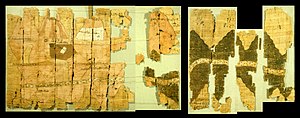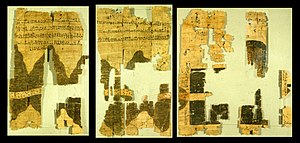Turin papyrus (map)

The Turin Papyrus is an ancient Egyptian map, the most important topographic map from around 1160 BC. Applies. The arch was found before 1824 in Deir el-Medina in Thebes by Bernardino Drovetti , who worked as Napoleon's proconsul in Egypt. The document is now kept in the Egyptian Museum in Turin .
origin
The map was made around 1160 BC. It was made by the famous scribe Amennachte (the son of Ipuys ) and served on a research trip of Ramses IV to the Wadi Hammamat in the Eastern Desert. The goal was outcrops of Precambrian meta greywacke rocks ( Bechen ) of the Arab-Nubian shield from which King stele should be made. Although the area around Bir Umm Fawakhir with Wadi Hammamat in the Egyptian eastern desert has already been mentioned as the location of the papyrus on various occasions in the specialist Egyptological literature, these assumptions could be clearly confirmed for the first time by Klemm & Klemm (1989) using aerial photographs.
Map content
The map shows a 15 km stretch of Wadi Hammamat, its confluence with Wadi Atalla and El-Sid , the surrounding hills, the Bechen quarry , a gold mine and the settlement at Bir Umm Fawakhir .
The map also contains numerous notes on the images, the destinations of the wadi courses, the distances between the quarry and mine, the gold deposits in the hills and the Bechenstein blocks in the quarry. The top of the map is oriented south towards the source of the Nile . As reconstructed in the Turin Museum, the map is said to have the dimensions 2.8 × 0.41 m, but this does not agree with more recent studies by Harrell and Brown (1992a, 1992b).
meaning
The document is not only the first, but already astonishingly modern, topographical map , but also the oldest known geological map , as it shows the locations of the various types of rock marked as black and pink hills, as well as the different, brown, green and white dots marked WADI gravel types indicates and also includes information for obtaining the stones and mine products.
The draftsman presented the features of the terrain clearly, carefully and in accordance with the actual conditions and increased the information content through notes and high-contrast colors.
literature
- James A. Harrell, V. Max Brown: The world's oldest surviving geological map. The 1150 BC Turin papyrus from Egypt. In: Journal of Geology. Vol. 100, 1992, ISSN 0022-1376 , pp. 3-18.
- James A. Harrell, V. Max Brown: The oldest surviving topographical map from ancient Egypt (Turin Papyri 1879, 1899 and 1969). In: Journal of the American Research Center in Egypt. Vol. 29, 1992, ISSN 0065-9991 , pp. 81-105.
- Rosemarie Klemm , Dietrich Klemm : Pharaonic gold mining in Wadi Sid and the Turin mine papyrus. In: Sylvia Schoske (ed.): Files of the Fourth International Egyptologists' Congress. Munich 1985. Volume 2: Archeology, field research, prehistory (= studies on ancient Egyptian culture. Supplement 2). Buske, Hamburg 1989, ISBN 3-87118-906-5 , pp. 73-87.
- Hansjust W. Walther: The Turin deposit papyrus. The oldest geological and geological map in the world. In: Journal of the German Geological Society. Vol. 145, 1994, ISSN 0012-0189 , pp. 1-6.
Web links
- Interpretative drawing of the Turin Papyrus ( Memento of October 10, 2007 in the Internet Archive ) in the Index of Cartographic Images illustrating maps from the Ancient Period: 6,200 BC to 400 AD on the website Cartographic Images (henry-davis.com) (English)
- World's First Geologic Map Was Far Ahead of Its Time. National Geographic , July 26, 2016 (English)
